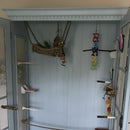Introduction: Pocket-Sized Nightlight, Low Voltage With Timer
This little gadget is for the the little kids.
It creates an ever changing palet of colorful lights on the wall and ceiling.
It uses the ever popular 555 timer (gateway drug equivalent in electronics) to turn itself off in 15 (+ or - 3) minutes.
The voltage in low enough to be battery operated but works best with a wall AC to DC transformer. 9 volts is best, plus safe for the kids.
And now for a video:
Step 1: Prepare to Shop at Ebay
Almost all the components used in this instructable was found on ebay.
My ebay search included but is not limited to:
- Slow fade RGB LED
- color changing LED
- 555 timer
- small tin container
- transistors
- MOSFET
- Capacitors
- switches
I am a little addicted to ebay.
Step 2: Parts and Tools
Here is the parts list:
- 10 color changing LEDs. RGB Slow change or Slow fade. Avoid "Fast Blink" RGB LEDS - this is a sleeptime nightlight for the kids, not a disco light system.
- 1 555 IC
- 1 power transistor or MOSFET
- 2 10 KOhm resistors
- 1 0.01 uF capacitor
- 1 36 Ohm resistor
- 1 1.8 M Ohm resistor
- 1 1 M Ohm resistor
- 1 470 uF electrolitic capacitor
- 1 NO momentary push button switch
- 1 power jack
- 1 small tin container with a clear lid
- Some wires
- Solder
- Glue
- a scrap piece of wood
Tools:
- Soldering iron
- wire cutters
- wire strippers
- dremel
- drill press or hand drill
- drill bits
Step 3: The Circuit
What we are using is a 555 IC set up into a "Monostable" configuration. What this means is that the 555 IC would output a signal when the button is pushed. The signal duration is based on the "RC" values. RC stands for Resistor-Capacitor. In our case, we have a 470 uF capacitor that is being charged through a resistor with a value of 1.8 mega ohms. The time it will stay on then turn off is based on RC Time Constant calculations (Google "RC Time Constant Calculator") which is 846 seconds. Now, given resistors can be off on there value + or - 5-10% and capacitor can be off by + or - 5-25%, the monostable signal can be anywhere from 13 minutes to 17 minutes. That's a good amount of time for the kids to get mesmerized by the slowly changing light show on the wall and ceiling and drift off to rainbow filled dreams for the night. the nightlight then turns itself off.
The circuit is so simple that I did not even bother making a circuit board. i just soldered directly to the legs of the 555 chip.
So here is the setup:
- Pin 1 - connects to ground
- Pin 2 - Trigger - connect to one side of switch and to one end of a 10 k-Ohm resistor. Connect the other end of the resistor to the POSITIVE side of the power supply. Connect the other side of the switch to GROUND.
- Pin 3 - Output - connect to 1 M-Ohm resistor. connect other end of resistor to GATE of MOSFET or transistor (more on mosfet below)
- Pin 4 - reset - connect to 10 k-Ohm resistor. Connect other end of resistor to POSITIVE side of power supply
- Pin 5 - control - Connect to 0.01 uF capacitor. Connect other end of capacitor to NEGATIVE side of power supply.
- Pin 6 - threshold monitor - BRIDGE Pin 6 and Pin 7 together. Connect the POSITIVE side of the 470 uF electrolytic capacitor to Pin 6. Connect the NEGATIVE side of the capacitor to the NEGATIVE (GROUND) side of the power supply.
- Pin 7 - Discharge - connect this pin to the R of or RC circuit. That is the 1.8 m-ohm resistor. Connect the other end of resistor to POSITIVE side of power supply.
- Pin 8 - VCC - this is the POSITIVE power leg. connect it to the POSITIVE side of the power supply.
I did not have a power transistor but I have a ton of irf610 MOSFETs. Why is a transistor or MOSFET needed. Well, the 555 IC can only handle 200 milliamps max. Ten LED's at 20 milliamps each is pushing that limit. The solution is to send the output signal coming out of PIN 3 into a 1 m-Ohm resistor and connect the resistor to the GATE of a MOSFET. Now the current going through the 555 output pin is probably less than the power to light 1 LED. The MOSFET can handle 1.5 Amps so 200 milliamp is nothing.
MOSFET wiring:
Attach the SOURCE leg of the MOSFET to the NEGATIVE side of the power supply.
Attach the DRAIN leg of the MOSFET to the 36 Ohm resistor. The other end of the resistor connects to the NEGATIVE side of the LEDs.
Attach the POSITIVE side of the LEDs to the POSITIVE side of the power supply.
Step 4: The LED Array
I made a template to make it easier to solder the LEDs together. In my case I wanted to make a star shape. i drilled 5mm holes in a piece of MDF (scrap piece of wood).
I inserted the LEDs into the holes makng sure to line up the legs.
I bent all the NEGATIVE legs into the center of the star. I then bent the POSITIVE leg of each LED so that it is touching the POSITIVE leg of the LED to its right.
So what I have is an array of 10 LEDs connected in Parallel.
I put a large gob of solder in the center to hold the negative leg of all the LEDs.
I soldered each positive leg of an LED to its neighboring LED to the right - positive leg to positive leg.
Trim the excess leads with wire cutters.
Find a 3 volt source and test the LEDs to make sure every one lights up.
Test fit into your container. Glue it down.
Step 5: Final Assembly
Drill a hole in your container for the switch and the power plug.
If using a tin container, insulate your circuit and cram everything in there.
plug into AC-DC transformer and press the button. it should now GLOW. In fifteen minutes (give or take 3 minutes) the light show should turn off.
Since everything is working it is now time to glue the container shut. This is for kids, so it is best if they can't open it.
congratulations. I hope the kids like it.

Participated in the
Pocket Sized Electronics













